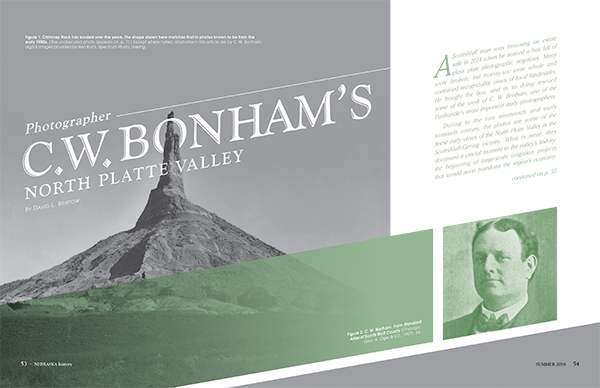A Scottsbluff man was browsing an estate sale in 2014 when he noticed a box full of glass plate photographic negatives. Many were broken, but twenty-six were whole and contained recognizable views of local landmarks. He bought the box, and in so doing rescued some of the work of C. W. Bonham, one of the Panhandle’s most important early photographers.
Dating to the late nineteenth and early twentieth century, the photos are some of the finest early views of the North Platte Valley in the Scottsbluff-Gering vicinity. What is more, they document a crucial moment in the valley’s history: the beginning of large-scale irrigation projects that would soon transform the region’s economy.
The purchaser of the negatives, Devin Jacobs, had them scanned and corrected by Ken Kurtz of Spectrum Photo in Gering, then sold the negatives to Jack Preston of the Legacy of the Plains Museum in Gering. All parties approved the publication of these photos in Nebraska History. Many of the images were printed as picture postcards in the early 1900s; reproductions of the postcards have occasionally been republished in books and articles. We believe, however, that this is the first time the photos have been published as a group, and the first time in more than a century that the images come directly from the original glass plates.
Clarence W. Bonham (1867-1934) was a businessman and professional photographer in Gering. His father, Rev. J. W. Bonham, M.D., was both a physician and an Episcopalian minister in New York City; his mother, Anna, was involved in the Woman’s Christian Temperance Movement and other moral crusades. But the Bonhams separated and in 1885 Anna moved to Cheyenne, Wyoming, relocating to western Nebraska in 1886. She claimed a homestead in Carter Canyon in southern Scotts Bluff County. When she was still “holding down her homestead” three years later, the Gering Courier remarked that the sixty-year-old “deserves a lot of credit for an old lady.”
Clarence apparently came west with his mother; he was living in the area at least by January 1888. He claimed a homestead five miles west of Gering, became involved in the community, and married in 1890.
Although some sources identify C. W. Bonham primarily as a photographer, he listed his occupation as “confectioner” in the 1900 U.S. Federal Census. He and his wife, Nettie, never had children of their own, but Gering children of the day had fond memories of Mr. Bonham, who “made the world’s best ice cream in a child’s mind,” according to a woman quoted in a local history. Another Gering resident remembered riding with his father in a horse and buggy to deliver milk to Bonham’s creamery on the south side of town. Mr. Bonham “would give me a dip of ice cream with a big soup ladle.”
Bonham was a man of diverse interests. His ice cream parlor and photography studio shared a building on Tenth Street. Bonham was among the shareholders of the first local telephone company, established in 1898 and which ran a line between Gering and Alliance. By 1901 he was vice president of the Gering Building and Loan Association, and in 1902-03 served as master of the local Masonic lodge. He was no longer working by the 1920 census, and he and Nettie were living in Florida when she died in 1927. Bonham latter married Nettie’s sister and spent his last years in Los Angeles, where he died in 1934.
The entire essay appears in the Summer 2016 issue.




